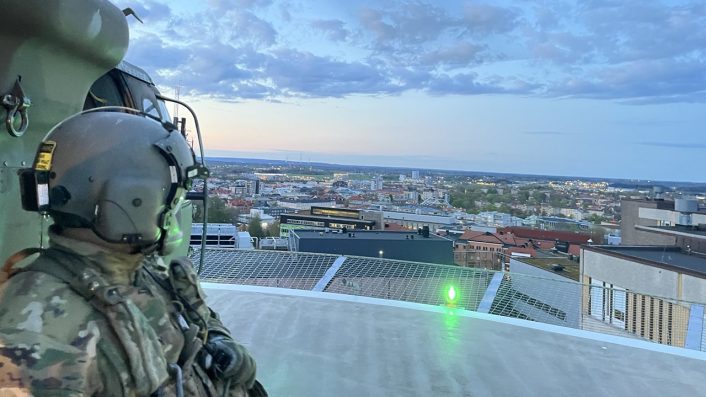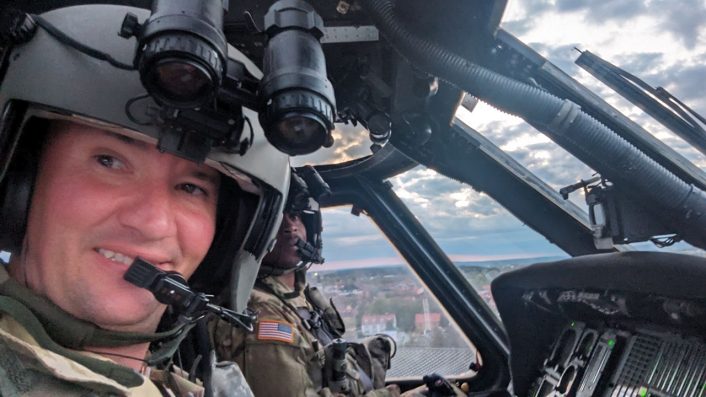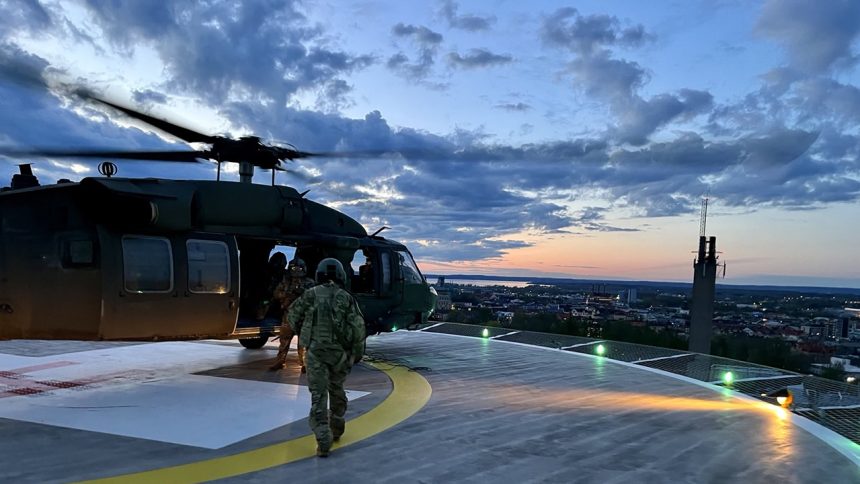As soon as Chief Warrant Officer Mike Grego was told he would be a back-up to the MEDEVAC helicopters, he researched satellite imagery, approaches to the helipads.
A Joint Forcible Entry Parachute jump drill during the NATO’s Exercise Swift Response saw a UH-60 pilot of the 8-229th Assault Helicopter Battalion land the chopper on a helipad atop a building, particularly in a foreign country, for the first time in his 18 years of service. The exercise was held in Sweden after the country’s accession to the military bloc in March.
Chief Warrant Officer 4 Mike Grego flew that rare CASEVAC (Casualty Evacuation) early this month, from the airfield in southern Sweden to the Linköping University Hospital, a nearly one-hour distance over the forested countryside.
‘Not Equipped nor Experienced in CASEVAC’
There are two reasons that made the flight particularly tricky, yet rewarding and successful, for Grego. Primarily, Grego’s UH-60 was not retrofitted with the emergency medical equipment like monitors, stretchers like the HH-60 models. He had “not fulfilled the role of a MEDEVAC pilot in years,” according to a press release from the ARAC (Army Reserve Aviation Command). Grego’s last MEDEVAC flight was with the 7th Battalion, 158th Aviation Regiment in Los Alamitos, California several years ago.
And, secondly, he was not part of a previous drill that involved “scouting the flight routes” and performing “landings at the hospital helipads in Linköping and Jönköping.” This was held by the Golf Company, 5-159th GSAB (General Support Aviation Battalion) MEDEVAC pilots and crew of “Task Force Tiger,” under Lt. Col. Stephen Morrow. The two major cities were within flight distance of the drop zone.
This is where a differentiation between MEDEVAC (Medical Evacuation) and CASEVAC would be warranted. MEDEVAC involves transporting injured persons using personnel and transport (aerial and ground) trained and equipped for medical emergencies. CASEVAC uses non-medical transports, both aircraft and ground vehicles with personnel not trained for medical duties.

Up to the Task, Nevertheless
“It was everything I wanted all rolled into one,” said Grego, who serves as the standardization pilot for 8-229th Assault Helicopter Battalion, based out of Fort Knox, Kentucky. “I didn’t want anything bad to happen to someone, but I wanted to have the opportunity to help out.”
Grego and a mixed crew of Army Reserve soldiers from across the United States responded to a call when the 173rd Infantry Brigade, along with multiple NATO allies, participated in the Joint Forcible Entry parachute jump into Hagshult Air Base, Sweden on May 7.
“I was the last-of-last options,” Grego said. But he was prepared. The next day, after Morrow’s exercise, TFT’s (Task Force Tigers) leaders briefed plans and contingencies with 11th Airborne, 173rd, and NATO allies from Hungary, Italy, and Spain. The main plan involved the TFT’s four HH-60 MEDEVAC Black Hawks “on hand to transport as many soldiers as they could carry.”
Grego and his crew came into focus when after “(running) the numbers, (they) realized…(that) a previous jump (alone could generate) an overwhelming amount of MEDEVAC lifts. (Thus) there could be the need for a CASEVAC operation,” Grego said.
Even training for a MEDEVAC/CASEVAC triggers “nervousness,” and requires the pilot to “take a couple of breaths and slow down,” anytime they are called for such a mission. Worse, a radio call during 173rd’s jump informed that one of the four MEDEVAC helicopters had issues early in its take-off procedures and would need to remain at the airfield. The responsibility befell upon Grego and his crew.
Grego’s team came from across bases in the US. The Flight Nurse Practitioner Major Mark Oherrick, and 8-229th co-pilot Chief Warrant Officer 2 Rashaun Carter came from Fort Knox. The crew chiefs Sergeant Skylar Ashley and Specialist Abdiel Rodgriguez-Gonzalez from Alpha Company, 2-135th GSAB at Joint Base Lewis-McChord, Washington; and Sgt. Kira Shoemaker, a critical care flight paramedic from Golf Company, 5-159th GSAB drills from MacDill AFB (Air Force Base), Florida.
‘Mission Accomplished’
As soon as he was told he would be a back-up to the MEDEVAC helicopters, Grego researched satellite imagery, approached the helipads, and remembered his training as a pilot. “I’ve got a lot of experience landing in a lot of places, I knew what to expect,” he said. “Landing to a pinnacle is essentially the same thing, whether it is landing atop a mountain or to the top of a building.”
He could also be prudent in his controls. While the 173rd Soldier’s life was not in danger, he had suffered an eye injury that medical professionals had determined needed immediate advanced medical care.

(Image credit: Chief Warrant Officer 4 Mike Grego)
After the bandaged soldier was escorted into his helicopter, Grego and Carter were immediately told: “take it easy, no sudden movements that could jeopardize the Soldier’s eyesight or possible concussion.” When the crew landed and medical personnel stepped off to assist, Grego and his co-pilot were able to snap a selfie on the rooftop, just as the sun began to set late and the skies began to turn a vibrant violet, burning red at the edges of the clouds floating above the cityscape.
In the end, the entire operation landed smoothly. “That’s how we train in the Army Reserve and for combat. We are here supporting our allies, coming from all across the country to work together. We hold ourselves to the standard; And Chief Warrant Officer 4 Grego demonstrates the true professionalism and dedication of our Soldiers in the Army Reserve always prepared, always ready,” Morrow said.









